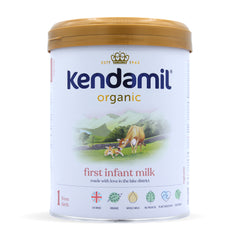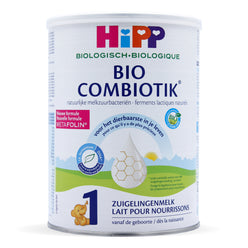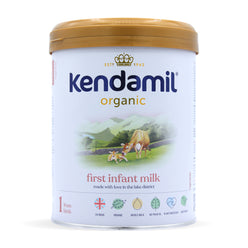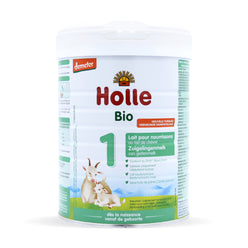Mixing Breastmilk and Formula
45 hours of research 5 minute read

Feeding your baby is a fundamental aspect of motherhood, and ensuring they receive the right balance of vitamins and nutrients is a top priority for healthy growth. While there are various feeding methods, sometimes relying solely on infant formula or breast milk may not be the most suitable option for various reasons. Can we mix breast milk and formula? In this article, we will thoroughly explore and shed light on this topic.
The Benefits of Breast Milk
Breastfeeding stands as a cornerstone in early infant care, offering a myriad of unparalleled advantages for both mother and child. Breast milk is universally recognized as the ideal nutrition for infants. It provides a unique blend of essential nutrients, antibodies, and other bioactive components crucial for a baby's healthy growth and development. Breastfeeding fosters a strong bond between mother and baby and offers unmatched health benefits that formula alone cannot replicate.
Optimal Nutrition
Breast milk is a remarkable source of nutrition, perfectly tailored to meet the evolving needs of the growing infant. Rich in antibodies, enzymes, and essential nutrients, breast milk provides a comprehensive and easily digestible foundation for a baby's healthy development.
Immunological Protection
One of the most remarkable benefits of breastfeeding is its ability to bolster the infant's immune system. Breast milk is laden with antibodies and immune cells that help protect against infections, illnesses, and chronic diseases, offering unparalleled immunological benefits.
Bonding and Emotional Well-being
Breastfeeding fosters a unique bond between mother and child, promoting emotional security and comfort. The skin-to-skin contact and the release of oxytocin during breastfeeding contribute to a strong emotional connection that positively impacts the baby's mental and emotional well-being.
Cognitive Development
Studies indicate that breastfed infants may have a cognitive advantage over formula-fed counterparts. The essential fatty acids and other nutrients found in breast milk are believed to support optimal brain development, contributing to improved cognitive function.
Lower Risk of Chronic Diseases
Breastfeeding has been associated with a reduced risk of various chronic diseases in both infants and mothers. From decreased rates of respiratory infections and gastrointestinal issues in infants to a lower risk of breast and ovarian cancers in mothers, breastfeeding offers long-term health benefits.
The Benefits of Formula Feeding
While breastfeeding is widely acknowledged as a gold standard for infant nutrition, formula feeding offers a viable and beneficial alternative. We want to help explore the various advantages associated with formula feeding, providing a comprehensive perspective on this important aspect of infant care.
Nutritional Consistency
Formula feeding ensures a consistent and standardized source of nutrition for infants. Unlike breast milk, which can vary in composition based on the mother's diet, formula provides a reliable blend of essential nutrients, promoting steady growth and development.
Accessibility and Convenience
Formula feeding offers a practical solution for mothers who face challenges with breastfeeding, whether due to medical reasons, lifestyle constraints, or personal choices. Formula feeding provides flexibility, allowing multiple caregivers to participate in feeding and easing the transition back to work for mothers.
Feeding Flexibility
Formula feeding allows parents to have more control over feeding schedules and amounts. This flexibility can be especially beneficial for parents with busy lifestyles or those looking for a feeding routine that aligns with their preferences and lifestyle choices.
Monitoring Intake
Formula feeding enables parents to easily monitor the baby's intake, providing a clear understanding of the amount consumed during each feeding session. This transparency can be reassuring for parents and caregivers, ensuring the baby receives adequate nourishment.
Shared Responsibility
Formula feeding facilitates shared responsibility among caregivers, allowing partners and other family members to actively participate in feeding. This inclusivity can contribute to a more balanced and supportive caregiving environment.
Can you mix Formula and Breastmilk?
Several circumstances may lead parents to opt for mixed feeding, such as low milk supply, breastfeeding-associated pain, the baby's feeding preference, parental comfort, and lifestyle factors like returning to work. Exclusive breastfeeding is recommended for the first six months, but if this isn't viable, supplementing with formula is a safe alternative.
Why Mix Breastmilk With Formula
Pros:
- Enjoy the benefits of both breastfeeding and formula feeding.
- Convenient for parents with a busy lifestyle.
- The formula can supplement a low milk supply.
- Availability of high-quality formulas catering to various dietary needs.
- Gradual adjustment to the taste of formula.
- Additional nutrition for the baby.
Cons:
- Potential waste of breast milk.
- Diminished milk supply with less frequent breastfeeding.
- Health risks associated with improper formula preparation.
- Baby preference for bottle feeding.
- Possibility of painful overfull breasts.
Selecting a premium formula to combine with breast milk is crucial for providing optimal nutrition to your baby. Many parents globally opt for European infant formulas due to their stringent quality standards and control measures. These formulas, exemplified by brands like HiPP, Holle, Lebenswert, Kendamil, Nannycare, Kabrita, and Aptamil, feature high-quality ingredients and are free from undesirable additives such as sucrose and corn syrup. Moreover, they are crafted without the use of GMOs, antibiotics, pesticides, chemicals, and preservatives, ensuring a healthier feeding choice for your little one.
How to switch to formula feeding
If you're considering transitioning to formula feeding, it's advisable to make the transition gradually, adhering to the suggested proportions. The entire process typically spans about two weeks, during which a combination of formula and breast milk is introduced. This mixing can conveniently be accomplished in a single bottle. The recommended ratios for each stage are as follows:
- 3⁄4 breast milk: 1⁄4 formula for the initial 4 days
- 1⁄2 breast milk: 1⁄2 formula for the subsequent 4 days
- 1⁄4 breast milk: 3⁄4 formula for the next 4-5 days or potentially one week
- Eventually, a complete shift to 100% baby formula.
In the same bottle, can you mix breast milk and formula?
While some parents practice this, it's crucial to consider factors such as preventing breast milk waste and maintaining the bonding experience of breastfeeding.
Most Popular Formula Options for Mixing with Breastmilk
While breastfeeding is the preferred method of infant feeding, there are situations where supplementing with formula becomes necessary. Understanding which formulas are trusted and popular among breastfeeding parents can provide valuable insight into ensuring your baby receives the best possible nutrition. In such cases, choosing formulas that closely mimic breast milk's composition can offer a reassuring option for both mom and baby. These formulas provide essential nutrients and can support healthy growth and development, guaranteeing that babies receive the nourishment they need, even when breastfeeding alone is not feasible. Below are some of the popular European baby formulas that most parents use as a supplement or alternative to breastmilk, especially when mixing breastmilk and formula to provide optimal nutrition for their babies.
1. HiPP Dutch
✓ 100% Organic formula
✓ With added prebiotics and probiotics to mimic breast milk
✓ HiPP's most popular formula
Check PricePopular With Parents Because: Renowned for its commitment to organic farming and sustainable practices, HiPP Dutch offers a formula that mirrors the composition of breastmilk closely. Packed with essential vitamins, minerals, probiotics, and prebiotics, HiPP Dutch provides optimal nourishment for infants, supporting healthy growth and development. Its gentle formulation ensures easy digestion, making it an excellent choice for supplementing breastmilk or transitioning to formula feeding.
✓ Contains milk fat globule membrane (MFGM) like in breast milk
✓ Vegetarian-friendly (contains plant-based DHA and ARA)
✓ EU and British Soil Association Certified Organic
Check PricePopular With Parents Because: Proudly crafted in the heart of England, Kendamil Organic stands out for its unwavering commitment to natural ingredients and traditional methods. Its gentle formula, free from palm oil and GMOs, exclusively uses full cream cow's milk to create a lactose-based infant formula that is as close to natural human breast milk as a formula can be made. Whether mixed with breastmilk or as a standalone feeding option, Kendamil Organic provides a gentle and nutritious choice for discerning parents.
✓ Demeter certified (Organic++)
✓ Easy-to-digest Goat Milk Formula Close to Breast Milk
✓ Popular for babies with sensitivity to cow's milk
Check PricePopular With Parents Because: For babies who may have sensitivities to cow's milk, Holle Goat Dutch formula offers a gentle alternative. Made with organic goat milk, this formula is easily digestible and provides a rich source of nutrients, including calcium, vitamins, and minerals essential for healthy growth and development. It is developed to closely resemble natural breast milk composition, making it an ideal choice for mixed feeding scenarios.
The Risks of Mixing Formula and Breast Milk
Feeding our infants is one of the most important aspects of parenting, and mothers often seek the best methods to provide optimal nutrition for their babies. In recent times, there has been a discussion about mixing formula and breast milk in the same bottle. While it may seem like a convenient solution, it's essential to explore the potential risks associated with this practice.
The Risks of Mixing Formula and Breast Milk in the Same Bottle
- Nutrient Imbalance:
Breast milk and formula are distinct in their nutritional composition. Mixing them in the same bottle may lead to an imbalance in nutrient levels, potentially affecting the baby's overall health. The precise balance of nutrients in breast milk can be disrupted when combined with formula.
- Contamination Risk:
The formula requires precise preparation to ensure safety and nutritional adequacy. Introducing breast milk into a bottle of formula may compromise the sterility of the formula and increase the risk of bacterial contamination, posing a potential threat to the baby's health.
- Storage and Shelf Life Challenges:
Breast milk and formula have different storage requirements and shelf lives. Combining them in one container may create challenges in terms of storage and monitoring expiration dates, leading to potential health risks if not handled meticulously.
- Potential Impact on Breastfeeding:
Introducing formula too early or inconsistently alongside breastfeeding may impact the baby's preference for one feeding method over the other. This could potentially lead to reduced breastfeeding frequency, affecting the mother's milk supply.
Mixing Formula And Breast Milk
In conclusion, while the concept of mixing formula and breast milk in the same bottle may seem practical, it comes with inherent risks that should not be overlooked. Most parents' common question would be is it okay to mix breast milk and formula? The potential nutrient imbalances, contamination risks, storage challenges, and impacts on breastfeeding make it crucial for parents to exercise caution and consult healthcare professionals before adopting such practices.
For the healthiest and safest feeding practices, it is advisable to follow guidelines provided by reputable health organizations and seek personalized advice from pediatricians.
Disclaimer: This information is based on general trends and not medical advice. Consult your doctor for personalized guidance on your child's feeding practices.
3 Most Popular Formulas For Breastfed Babies
References:














Clara J -
When I was struggling with night feeds and trying to balance breastfeeding with formula, I wish I had known about the benefits of mixing breast milk and formula. It would have made those late-night sessions so much easier and less stressful. I was always worried about the right timing and how to mix them properly, but learning more about the process could have saved me a lot of trial and error. If you’re in the same boat, I highly recommend reading up on it—it could really help make things smoother for both you and your baby.
Charity S -
What would you recommend for parents who want to combo-feed but don’t want to mess with all the rules? I swear, every time I think I’ve got a good system, I find out I’m apparently doing something wrong. 🤦♀️ I know mixing formula and breast milk in the same bottle isn’t ideal, but what about alternating—breastfeeding during the day and formula at night? Or even paced bottle feeding to keep things balanced? I just want my baby fed, happy, and preferably not treating me like an all-you-can-eat buffet 24/7. Any tried-and-true tips?
Janet S -
I’ve heard so many different opinions on mixing breastmilk and formula, and it’s hard to know what’s best. Some people say it’s totally fine, while others warn that it can upset a baby’s stomach or cause nipple confusion. I’ve been considering combo feeding, but I worry about whether my baby will still want to nurse if I introduce formula. Has anyone found a method that makes the transition easier? I’d love to hear what’s worked for other parents who have done both.